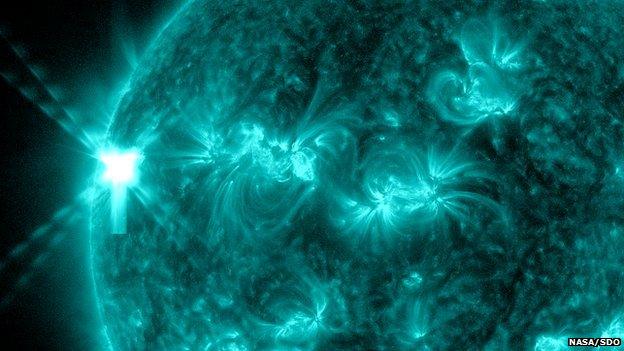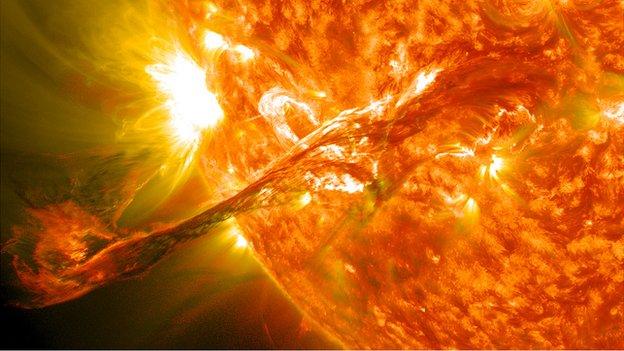Four colossal Sun flares in 48 hours
- Published

The flares are the strongest unleashed in 2013 so far
The Sun has unleashed four colossal bursts of radiation in 48 hours.
On Tuesday, it released the biggest solar flare of 2013 so far, an intense burst associated with a huge eruption of particles.
When these eruptions reach Earth, they can interfere with satellites and communications systems on the ground.
The sunspots that spawned these flares are not directly facing our planet, but some Nasa spacecraft could be in the path of the solar particles.
Increased numbers of flares are expected at the moment because the Sun's normal 11-year activity cycle is approaching its peak - known as a solar maximum - this year.
Dr Robert Massey, from the UK's Royal Astronomical Society, told the BBC: "What's interesting about these events is that you have them in quick succession.
"It really does say that we're approaching this 11-year peak. We can't say exactly when it's going to happen, you can only work it out retrospectively."
Despite this, the Sun had - up until the most recent events - been relatively quiet in 2013. Sunspot numbers had been below values in recent years and strong flares had been infrequent.

Eruptions such as this one in August last year, demonstrate the raw power of our parent star
The intense bursts of energy this week were all "X-class" flares - the strongest type.
These are assigned a number which gives more information about their strength: An X2 is twice as intense as an X1, an X3 is three times as intense, and so on.
The first of the recent flares, which was given an X1.7 designation, appeared at 0317 BST on Monday 13 May. That was followed by an X2.8-class flare at 1709 BST on the same day and an intense X3.2-class flare at 0217 BST on Tuesday.
These flares - the strongest solar activity of 2013 - occurred in the space of just 24 hours.
According to the Space Weather website, a fourth, X1-class flare was unleashed at 0252 on Wednesday.
"These are spectacular events, an X-class flare is equivalent to a billion hydrogen bombs. We're talking about a colossal amount of energy," said Dr Massey.
"The good news is that although these can cause problems - at worst - with power supplies and so on, there's really no threat to us living on the ground."
Footage from Nasa shows massive flares on the Sun's surface
When intense enough, flares can disturb the Earth's atmosphere in a key layer, the ionosphere, through which GPS and communications signals must travel. This disrupts the radio signals for as long as the flare is happening.
Flares are associated with huge eruptions of matter from the Sun's atmosphere - known as coronal mass ejections (CMEs).
These CMEs can be even more disruptive because they are capable of sending billions of tonnes of charged gas and other particles into space. When powerful eruptions reach Earth, the charged matter can blow out transformers in power grids as well as tripping electronics on satellites.
The so-called Carrington Event of 1-2 September 1859 shorted telegraph wires, starting fires in North America and Europe, and caused bright aurorae (northern and southern lights) to be seen in Cuba and Hawaii.
Nasa says its Stereo-B and Spitzer spacecraft may be in the paths of the mass of particles unleashed by these recent events. The operators of those science missions can choose to put their spacecraft into a "safe mode" to protect the electronics in onboard instruments from being tripped.
"It's a really important area for economic reasons because if we don't learn how to protect satellites and the equipment we depend on, there is a serious issue there," said Dr Massey.
Paul.Rincon-INTERNET@bbc.co.uk and follow me on Twitter, external
- Published9 March 2012
- Published14 May 2013
- Published7 February 2013
- Published9 March 2012